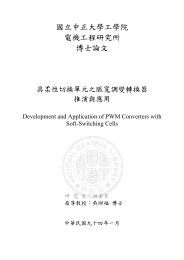Syntax of the Bi Comparative Construction in Mandarin Chinese
Syntax of the Bi Comparative Construction in Mandarin Chinese
Syntax of the Bi Comparative Construction in Mandarin Chinese
You also want an ePaper? Increase the reach of your titles
YUMPU automatically turns print PDFs into web optimized ePapers that Google loves.
<strong>Syntax</strong> <strong>of</strong> <strong>the</strong> <strong>Bi</strong> <strong>Comparative</strong> <strong>Construction</strong> <strong>in</strong> Mandar<strong>in</strong> Ch<strong>in</strong>ese<br />
prepositions, and verbs as well. Her (2006) exam<strong>in</strong>es <strong>the</strong> orig<strong>in</strong>al account for <strong>the</strong><br />
syntactic categories <strong>of</strong> gei <strong>in</strong> MC by T<strong>in</strong>g and Chang (2004), <strong>in</strong> which gei may act<br />
ei<strong>the</strong>r as a verb, a preposition, and even a complementizer. Among all, gei can be a<br />
complementizer <strong>in</strong> <strong>the</strong> goal-mark<strong>in</strong>g structure like (98) where gei-NP is not a PP<br />
subcategorized for by <strong>the</strong> predicate, as shown <strong>in</strong> (99a~b).<br />
(98) [V NP gei NP VP]<br />
(99) a. wo chang-le yi shou ge [CP gei [IP ta t<strong>in</strong>g]] (Her 2006)<br />
I s<strong>in</strong>g-ASP one CL song GEI she listen-to<br />
‘I sang a song for her to listen to.’<br />
b. *wo chang-le yi shou ge [P gei] ta.<br />
I s<strong>in</strong>g- ASP one CL song to she<br />
‘I sang a song to her.’<br />
T<strong>in</strong>g and Chang (2004) also cite b<strong>in</strong>d<strong>in</strong>g facts and prosodic features to support <strong>the</strong>ir<br />
analysis on <strong>the</strong> complementizer <strong>in</strong> MC. Their analysis do not complicate <strong>the</strong> grammar<br />
given <strong>the</strong> <strong>in</strong>dependently motivated complementizer <strong>of</strong> shuo, as <strong>in</strong> (100b), which<br />
likewise has arisen from <strong>the</strong> grammaticalization <strong>of</strong> <strong>the</strong> verb shuo ‘say’, as <strong>in</strong> (100a).<br />
Thus, shuo as a complementizer is similar to that <strong>in</strong> English and gei is like for <strong>in</strong> <strong>the</strong><br />
“for-to construction.” 12 However, unlike <strong>the</strong>ir English counterparts, MC<br />
complementizers needs to be licenses and thus cannot stand alone, as <strong>in</strong> (101).<br />
12 The purposive gei is parallel to <strong>the</strong> ‘for..to’ construction <strong>in</strong> English<br />
(i) Wo fei [CP gei [IP ni kan e]] (Her 2006)<br />
I fly GEI you watch<br />
‘I will fly for you to watch.’<br />
(ii) ‘I will fly for you to watch.’<br />
59<br />
中正大學 e-Thesys (94 學年度)





